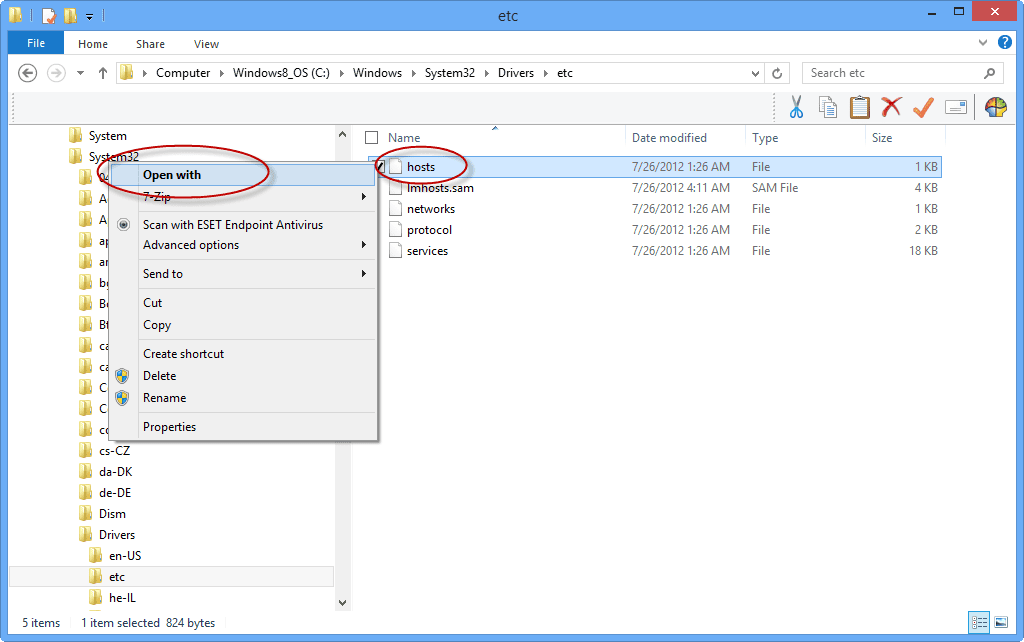

- #Modify hosts file in windows 8 install
- #Modify hosts file in windows 8 code
- #Modify hosts file in windows 8 windows 8
IPHostEntry host = Dns.GetHostEntry(Dns.GetHostName()) Right-click the hosts file and select Open with. You might want to rename it something like hosts.old or hosts.original. Make a backup copy of hosts file by simply copying the hosts file and then pasting it. HOSTFILE = Path.Combine(Environment.GetFolderPath(), "hosts") Editing the Hosts File Start Windows File Explorer and go to C:\Windows\System32\drivers\etc folder. HOSTFILE = Path.Combine(Environment.GetFolderPath(), no windows NT

#Modify hosts file in windows 8 code
So every time I start the program it checks if the text that I want to add ( 123.123.123.123 ) and if it isn't written in the hosts file it adds it and continues running the code and if it is it skips and doesn't add 123.123.123.123 and continues running the code.Ĭonsole.ForegroundColor = ConsoleColor.Red To exclude the hosts file from being monitored in Windows Defender, first open Windows Defender – press the Windows key, type Windows Defender, and press Enter.Ĭlick the Settings tab and select the Excluded files and locations category.I am looking to edit the hosts file at C:\Windows\System32\drivers\etc Even if you’re a careful computer user, having multiple layers of protection is a good security practice. You can also disable Windows Defender entirely, but that isn’t a good idea unless you’re using a third-party antivirus.
#Modify hosts file in windows 8 install
When you install a third-party antivirus, Windows Defender will disable itself.
#Modify hosts file in windows 8 windows 8
To prevent this from taking place, Windows 8 (more specifically, the Windows Defender antivirus included with Windows 8) monitors your hosts file. A user would look at their address bar, see, and never consider that they may be looking at a phishing site. The malicious website could even be disguised as. For example, the malware could point at a different IP address entirely – one run by a malicious organization. In the File name field, paste c:WindowsSystem32driversetchosts. Unfortunately, malware often edits the hosts file to add such lines. Modify Hosts File in Windows Right-click on the Notepad icon and select Run as administrator.

It won’t find a web server, so the connection will immediately fail. When someone tries to access on your computer, your computer will attempt to connect to itself at 127.0.0.1. Some people use this trick to block websites – for example, you could point at 127.0.0.1, which is your computer’s local IP address. By editing your hosts file, you can point at any IP address you want. Your hosts file is a file, local to your computer, that can override this behavior. This file acts as a local DNS service, for your local computer, and it overrides the mappings from the DNS server that your computer is connected to, through the network. From Notepad, open the following file: c:\Windows\System32\Drivers\etc\hosts Make the necessary changes to the file. The Hosts file (also referred to as etc/hosts) is a text file used by Windows (and other operating systems) to map IP addresses to host names or domain names. Your computer will then connect to this numerical IP address and access the website. In the search results, right-click Notepad and select Run as administrator. When you access a website, your computer contacts your domain name system (DNS) server and requests its numerical IP address.


 0 kommentar(er)
0 kommentar(er)
